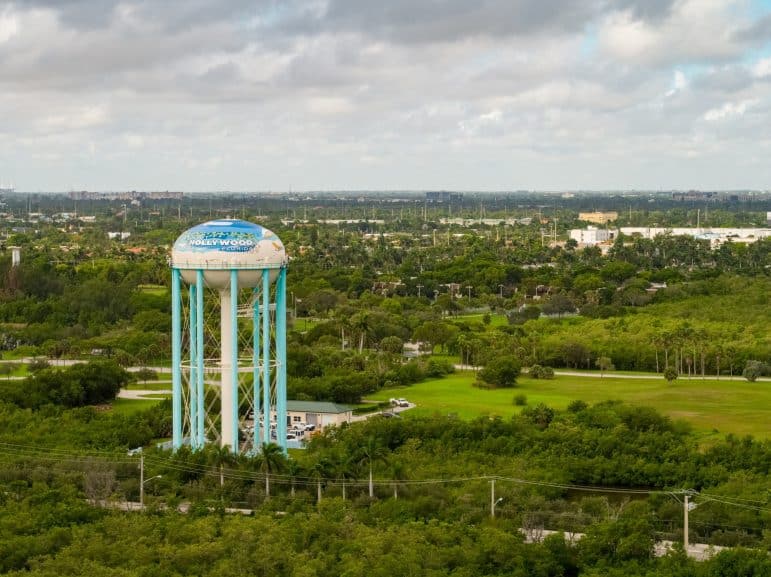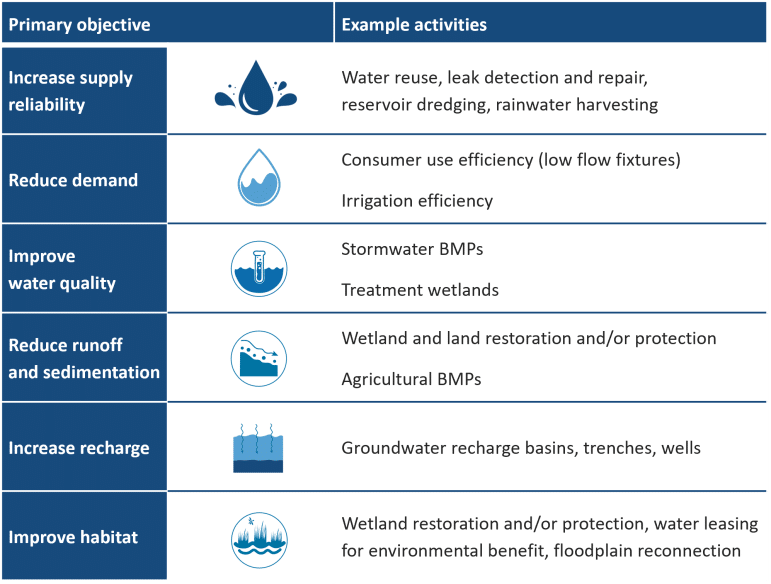
What Water Utilities Should Know About Corporate Water Stewardship
Communities and businesses rely on water utilities for a safe, reliable water supply. The goals of water utilities and companies with water stewardship commitments align closely, and engagement between these entities has the potential to benefit both and improve water security.
By Penelope Moskus, Principal & Environmental Scientist (Ann Arbor, MI) and and Steve Skripnik, Principal & Environmental Engineer (Los Angeles, CA)
June 17, 2025
Water Utilities Rely on Sustainable Water Sources
Communities and businesses rely on water utilities for a safe, reliable water supply. In turn, water utilities rely on sustainable water sources. Companies increasingly recognize the importance of engaging in the communities and watersheds where they operate to reduce water-related risks. This engagement often takes the form of corporate investment in projects that increase supply reliability, reduce demand, protect or restore hydrology, and improve water quality or habitat. While these investments mostly focus on reducing water-related risks for companies, these same projects can benefit water utilities and other water users.
Because these [water stewardship] investments often focus on reducing water-related risks for the basins and communities these companies rely on, these same projects can benefit water utilities and other water users.
While risk management will always be a major driver for corporate investment in water, companies also invest in water to meet water sustainability and stewardship commitments that are part of their accountability to shareholders. Corporate water balance goals facilitate stakeholder engagement and drive project investment. A typical goal specifies a volumetric target the company aims to meet by a specific date, frequently in specific geographies such as the communities and watersheds where the company operates.
Risk Reduction and Water Stewardship Goals are Critical to Companies and Drive Investments
Both risk reduction and stewardship goals are critical to companies and drive investments in the regions where they operate. Companies may engage with utilities or others in these regions to learn about and invest in projects that are also of interest and a benefit to utilities.
Some example activities are listed below.

What Utilities Should Know When Discussing Collaborative Opportunities with Companies
Before engaging with corporations to discuss collaborative opportunities, utilities should be aware that:
- Companies often want to report the volumetric water benefits of projects they invest in. The generally accepted and widely used methodology for calculating volumetric water benefits is VWBA (2019), with an update (VWBA 2.0) scheduled for release in fall 2025.
- For a project to have a volumetric water benefit, six essential project criteria must be met. One of these is that the project activities should not be legally required by the company claiming the volumetric benefits. VWBA 2.0 outlines these criteria.
- Companies may target their investment in specific geographies. Companies set investment goals based on regions where they operate or where they are exposed to operational risks to their supply chains. The projects of interest and desire to collaborate with other funders may vary by company.
- Companies may have specific reporting requirements and may expect the utility to conduct monitoring and maintenance for the duration of their benefit claims.
Collaboration Between Water Utilities and Companies with Common Goals can Result in Mutual Benefits and Improve Water Security
The goals of water utilities and companies with water stewardship commitments align closely, and engagement between these entities has the potential to benefit both and improve water security. LimnoTech has been working with municipal utilities and corporate clients for decades and often helps clients identify opportunities to explore common goals in watersheds where corporate and municipal entities share common interests. We’re excited to explore new opportunities with clients and partners.
If you would like to learn more about water stewardship and how water utilities and companies can work together, please contact Penelope Moskus at pmoskus@limno.com or Steve Skripnik at sskripnik@limno.com.
Penelope Moskus is a Principal and Senior Environmental Scientist with 30 years of experience. Penelope co-directs LimnoTech’s corporate water stewardship practice area, helping clients develop strategies, guidance, and tools to reduce water-related risks and supporting clients with water stewardship program implementation. She advises clients on project selection, has evaluated volumetric and complementary benefits of hundreds of potential and funded projects, and annually supports corporate reporting for numerous companies. Penelope has supported a major corporation’s replenishment program for 15+ years, including strategy development; development of replenish guidance; quantification and reporting of replenish benefits; validation, verification, assurance, and advising on internal audits. She also supports global and local NGOs, food and beverage companies, energy providers, high-tech companies, agricultural providers, and supermarket chains. Penelope contributed to a landmark paper on Volumetric Water Benefit Accounting (VWBA) and is one of the authors contributing to an update (VWBA 2.0). She has piloted Water Quality Benefit Accounting (WQBA) and is a Professionally Credentialed Specialist Consultant for the AWS Standard.
Steve Skripnik, PE, is a Principal and Senior Environmental Engineer with expertise working with public and private sector clients to navigate complex water-related issues. Steve has managed projects related to stormwater runoff and watershed management issues, surface water hydrology, low-impact development, complex environmental data management, and sustainability issues. Steve’s project experience includes developing and applying various watershed hydrology, storm and sanitary sewer collection systems, receiving water models, and working with clients to create plans that are resilient to a changing environment. His diverse project experience includes water stewardship, watershed planning, stormwater quality and conveyance, and water supply planning. Steve serves a broad range of client groups, including municipal and industrial sectors, state and federal agencies, and nonprofit organizations. Steve is committed to helping clients make informed management, risk, and design decisions using sound data analysis, monitoring, modeling, and decision systems.




